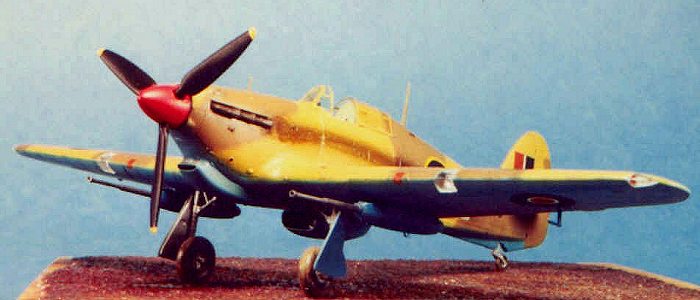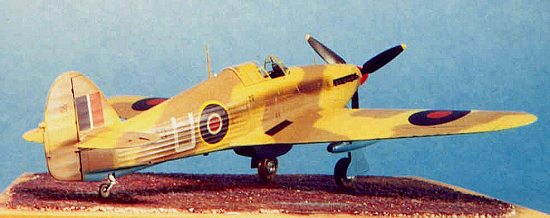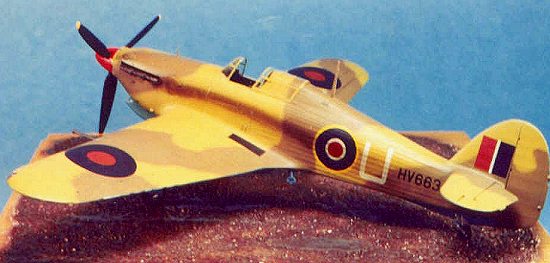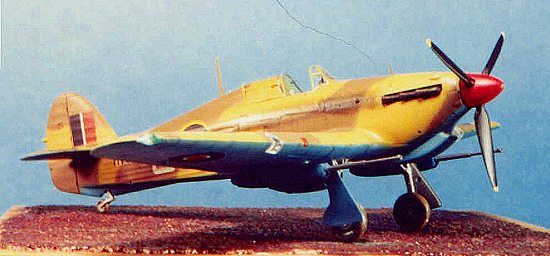
|
KIT: |
Hasegawa 1/48 Hurricane IID |
|
KIT # |
9052 |
|
PRICE: |
$21.98 |
|
DECALS: |
Two 6 Sq aircraft |
|
REVIEW & |
|
|
NOTES: |
` |

|
HISTORY |
A hallmark of a true thoroughbred in aircraft is the ability to adapt the design for purposes never conceived at the time of its initial acceptance, and have the airplane perform that task well. The Hurricane did this in spades, going from day fighter armed with eight rifle-caliber machineguns to heavily-armed fighter-bomber with 20mm cannon and bombs, to carrier fighter, to "can opener." This was the sobriquet attached to the Hurricane IID, an airplane that did as much if not more than others to overcome the German superiority in armored fighting vehicles in the western desert of North Africa.
 Six months after the
introduction of the cannon-armed Hurricane IIC "Hurribomber" in the
North African fighting in December 1941, the Hurricane IID made its debut. The
wing had been modified to carry two Vickers Type "S" 40mm cannon with
fifteen rounds per gun. While these guns were not capable of penetrating the
thicker forward armor of German tanks, they were fully capable of penetrating
the less heavily-armored rear of the vehicle where the engine was. The wing
itself had two .30 caliber Brownings for sighting purposes. The airframe was
modified with additional armor to protect the pilot, radiator and engine from
small-arms fire. With all this additional weight, the "can opener" had
a maximum speed of 286 m.p.h., which was plenty for battlefield conditions.
Six months after the
introduction of the cannon-armed Hurricane IIC "Hurribomber" in the
North African fighting in December 1941, the Hurricane IID made its debut. The
wing had been modified to carry two Vickers Type "S" 40mm cannon with
fifteen rounds per gun. While these guns were not capable of penetrating the
thicker forward armor of German tanks, they were fully capable of penetrating
the less heavily-armored rear of the vehicle where the engine was. The wing
itself had two .30 caliber Brownings for sighting purposes. The airframe was
modified with additional armor to protect the pilot, radiator and engine from
small-arms fire. With all this additional weight, the "can opener" had
a maximum speed of 286 m.p.h., which was plenty for battlefield conditions.
The aircraft arrived in June 1942 and were assigned to 6 Squadron. By the time of the Battle of el Alamein, the squadron had developed successful tactics against both soft-skinned vehicles and armored fighting vehicles. During the battle and the German retreat across North Africa into Tunisia, the Hurricane IID became the scourge of Rommel's armored units, littering the desert with hundreds of burned-out hulks. Following the Allied advance into Italy, the Hurricane IIDs were used over the Balkans for hunting German armor. In the Far East, Hurricane IIDs stopped Japanese armor cold in the Battle of Imphal, and were also used in strikes against coastal shipping in Burma.
|
THE KIT |
Hasegawa is well-known for getting maximum mileage out of any of their basic kits. The Hurricane is no departure, as a modeler can now do one of every sub-type of the airplane. In this case, the kit comes with an extra tree of parts for the 40mm cannon, as well as decals for two aircraft of 6 Squadron operating in North Africa in 1942.
|
CONSTRUCTION |
 Construction of the
kit proceeds as do all the others, with the exception that you drill out the
holes on the underside of the wing for attaching the cannons and their fairing.
My only complaints about the kit is the poor choice of a join line on the lower
fuselage for the wing, which means you have to putty over a fabric area, then
come back with rat-tail files and reshape that area, and that the canopy is
provided only in the closed position. I vacuformed a new one on my old Mattel,
and took the time to fair in the "ledge" behind the cockpit. The
kit-supplied cockpit is - to me - more than adequately detailed, so with the
addition of seat belts made of lead foil, the model was ready in a day to head
for the paint shop after a night spent allowing everything to thoroughly set up.
Construction of the
kit proceeds as do all the others, with the exception that you drill out the
holes on the underside of the wing for attaching the cannons and their fairing.
My only complaints about the kit is the poor choice of a join line on the lower
fuselage for the wing, which means you have to putty over a fabric area, then
come back with rat-tail files and reshape that area, and that the canopy is
provided only in the closed position. I vacuformed a new one on my old Mattel,
and took the time to fair in the "ledge" behind the cockpit. The
kit-supplied cockpit is - to me - more than adequately detailed, so with the
addition of seat belts made of lead foil, the model was ready in a day to head
for the paint shop after a night spent allowing everything to thoroughly set up.
|
PAINT & DECALS |
Painting:
I used Gunze-Sanyo colors for this model. While Gunze does not make a British "Azure Blue," I used a mixture of Intermediate Blue and Sky Blue to get the correct color. The upper camouflage was painted freehand over a pre-shading of flat black airbrushed over all the panel lines. Once this was done and the paint had dried, I shot the model with two coats of Future and allowed it to dry overnight.
Decals:
 I used the kit decals,
which go down well under Micro-Sol, needing only a final hit of Solvaset after
they have set up to get them to snug down into the surface. I did the later set
of markings of the two provided, since I have a book on British aircraft of the
Second World War in color, which shows this airplane ready to take off from a
desert field during El Alamein.
I used the kit decals,
which go down well under Micro-Sol, needing only a final hit of Solvaset after
they have set up to get them to snug down into the surface. I did the later set
of markings of the two provided, since I have a book on British aircraft of the
Second World War in color, which shows this airplane ready to take off from a
desert field during El Alamein.
Final Finish:
The sand and small rocks of the desert mean that the leading edges of the wings are badly dinged. The prop, being wooden, does not have and dings, though the paint would be worn away from the outer third of the blade. The photograph I had showed the airplane with heavy exhaust staining down the entire fuselage side, which I recreated with Tamiya "Smoke." Once all this was done, I gave the model two coats of "Flat Future" and it was done.
|
CONCLUSIONS |
Hasegawa's Hurricane is a well-designed kit, other than the two bad points noted in construction, that makes up into as accurate a model of this famous airplane as we are likely to have available for the foreseeable future. With the addition of this Hurricane IID to my collection, I now have at least one of each variant of Hurricane, in the roles it was best known for. I would rate this an "easy long weekend project" due to the ease of assembly.
If you would like your product reviewed fairly and quickly by a site that averages over 2,600 visits a day, please contact me or see other details in the Note to Contributors.